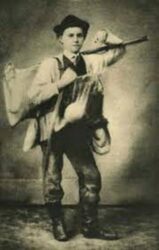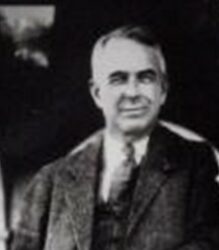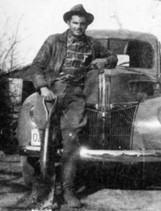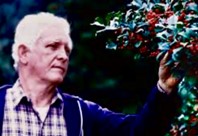By Ken Johnson
We are incredibly fortunate to have access to a world-class Arboretum right here in Kentucky. Bernheim Arboretum was named Kentucky’s Official Arboretum, and in 2023, received renewed accreditation as an ArbNet Level IV (the highest level) arboretum and obtained accreditation through Botanical Garden Conservation International (BGCI). This gem did not develop without hard work and many factors coming together.
The Dream

Isaac Bernheim possessed a dream from his early days as a young man growing up near the Black Forest in Germany. The dream evolved during his early time in America as an 18-year-old peddler in the wooded hills of northeastern Pennsylvania and remained with him as he developed his successful business in making and selling bourbon while living first in Paducah and later on in Louisville. He related that this dream became more focused as he walked with his beloved wife, Amanda, through his 300-acre estate, Homewood, in Anchorage, Kentucky. When Amanda passed away in 1922, Isaac moved to Denver, Colorado; the dream was pushed to the side – but not forgotten.
Five years later, in 1927, Isaac began his search for a piece of land where he could not only create an arboretum but also have a large area where he could protect the land and the creatures that would call it home. In May of 1928, he purchased 12,500 acres of land in Bullitt and Nelson counties for that purpose. A year later he created the Bernheim Foundation to make those dreams come to life.

The Plan
Isaac dreams but he lacked the expertise to make it become reality. Neither he nor the distinguished people he appointed as trustees of the Foundation had training or experience in a project of this size or scope. After a few years of surveying and mapping the property, he turned to the famed landscape designers, the Olmsted Brothers of Brookline, Massachusetts. Mr. Bernheim had previously employed the services of the Olmsted firm for other landscaping projects including Homewood, the town of Anchorage, and the library he donated to Hebrew Union College in Cincinnati. James Frederick Dawson, a partner in the Olmsted Brothers firm and talented landscape architect, was assigned the project.
In 1935, the design was presented to the Bernheim Foundation and was accepted. The Olmsted Brothers and Mr. Dawson would continue to assist in the project for many years.
The Implementation
While much discussion of the plans and how to execute them would continue over the next years, most of the work would have to wait. Isaac Bernheim had specified that most of the money in his estate would not become available until several years after his death. Through most of the 1930s and the first half of the 1940s, the budget for developing the forest was limited to about $14,000 a year. Even considering the higher buying power in those years it was obvious that most of the development of the arboretum would have to wait. For much of that time, the land that is now the arboretum was planted in crops such as corn and hemp or rented out as pasture. The biggest project in the arboretum area in the 1930s was the creation of the three small ponds in 1939 that were then known as Cedar Lakes #1, #2, and #3 – now known as the Olmsted Ponds and Mac’s Lake.

On April 1, 1945, Isaac Bernheim passed away at the age of 96. His longtime assistant, Robert Paul, assumed the position of Executive Director of the Foundation. He would remain in that position for over 36 years until his death in 1981.
There is very little growing in the arboretum that dates back to the 1930s and 1940s. Several young pine trees were dug up elsewhere on the property and replanted in an area that was long called the Pines Picnic Area. This area was in the location where the Visitor Center and the children’s play area, Playcosystem, are today. Many of the maples in the Maple Section to the right of the entrance gate were also planted in the 1940s.
On March 1, 1950, Frank Bunce was hired as Forest Manager. Just four short months later, on the first of July, Bernheim welcomed the public to visit the forest. The Arboretum remained mostly an unrealized dream. Lake Nevin had been created the previous year and its banks were still mostly bare dirt. A road had been built from the entrance and wound its way around the property and connected to the road to the fire tower. That road had also been recently completed.

As primitive as the arboretum was, it provided a rough canvas for Mr. Bunce to begin the work of bringing it to life. The next years saw many changes. In 1952 the initial planting of ginkgoes was completed, followed in 1954 by the beeches, and in 1956 by the planting in the Memorial Area after the move of the remains of Isaac and Amanda Bernheim from Louisville’s Cave Hill Cemetery. The large bronze tablet on the slope of Holly Hill was put in. The arboretum continued to develop in the following years with the Chestnut Collection and Oak Collection in 1957. The buckeyes and horse chestnuts were added in 1958. Many of the crabapples were planted in the 1960s.
In 1962 Clarence ‘Buddy’ Hubbuch was hired as Bernheim’s first horticulturist. The development of the Arboretum then started to progress at a rapid pace.
With a Little Help From Our Friends
Actually, quite a lot of help. Buddy Hubbuch was working at the Boone Gardiner Nursery in Louisville when he met Frank Bunce, the Bernheim Forest Manager. Hubbuch made a favorable impression and was offered the position of Bernheim’s Chief Horticulturist. Buddy started work in November 1962 and quickly made a huge difference. He found numerous ways to improve the arboretum and used a scientific approach in implementing the Olmsted plan while incorporating his own vision.


With a still limited budget and a desire to greatly increase the variety of trees and other plants within the arboretum, Buddy turned to his contacts at other arboretas, botanic gardens, and nurseries for assistance. They responded. Over the next years, over 20 arboreta, botanic gardens, nurseries, and individuals donated trees and shrubs to enhance Bernheim’s collection. Bernheim received plants from the United States Botanic Garden, the Cincinnati Zoo, North Carolina State University, and many others around the region and the country. The most generous benefactor was Theodore Klein of Oldham County who gave over 90 plants from his nursery to Bernheim which now can be found in every corner of the Arboretum. Mr. Klein’s biggest gift was over 75 varieties of holly that formed the foundation of what would become the Hubbuch Holly Collection. The collection now consists of over 140 varieties and is renowned as one of the best in the country. The Klein Nursery was transformed after Theodore Klein’s death in 1993 and is now known as the Yew Dell Botanical Gardens.
The Arboretum Today
 Buddy Hubbuch retired from his job at Bernheim in 1995 after 33 years of dedicated service. The plant collection has continued to grow with more interesting plants added; the oaks, maple, ginkgoes, and a myriad of other species have grown from saplings into mature trees. Numerous pieces of art have been added, including the very popular Forest Giants created by 2019 Artist in Residence, Thomas Dambo. Hundreds of thousands of visitors visit the Arboretum every year and fulfill Isaac W. Bernheim’s vision as expressed in 1929 of this special place becoming the “(C)enter of friendly meeting for the people of Kentucky and their friends, as a place to further their love of the beautiful in Nature, and in kindred educational and cultural subjects, and becoming a means of strengthening their love and devotion to their State and Country.”
Buddy Hubbuch retired from his job at Bernheim in 1995 after 33 years of dedicated service. The plant collection has continued to grow with more interesting plants added; the oaks, maple, ginkgoes, and a myriad of other species have grown from saplings into mature trees. Numerous pieces of art have been added, including the very popular Forest Giants created by 2019 Artist in Residence, Thomas Dambo. Hundreds of thousands of visitors visit the Arboretum every year and fulfill Isaac W. Bernheim’s vision as expressed in 1929 of this special place becoming the “(C)enter of friendly meeting for the people of Kentucky and their friends, as a place to further their love of the beautiful in Nature, and in kindred educational and cultural subjects, and becoming a means of strengthening their love and devotion to their State and Country.”

